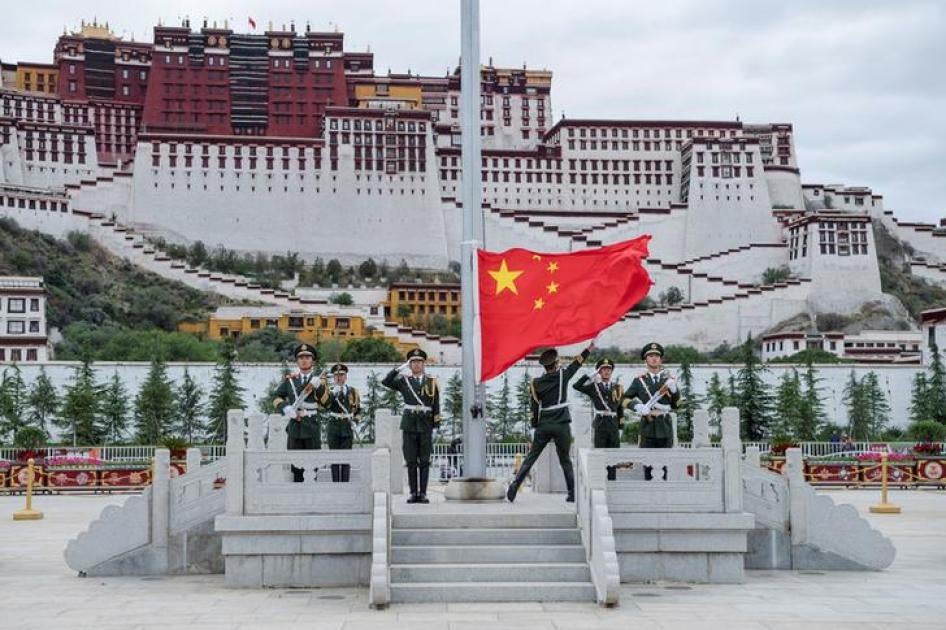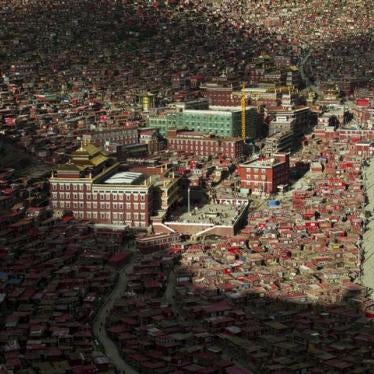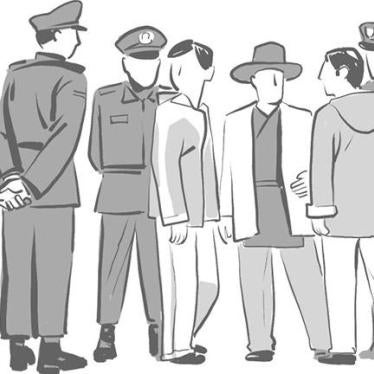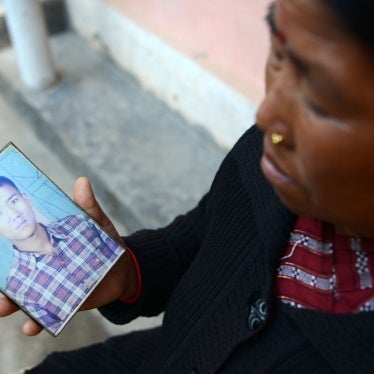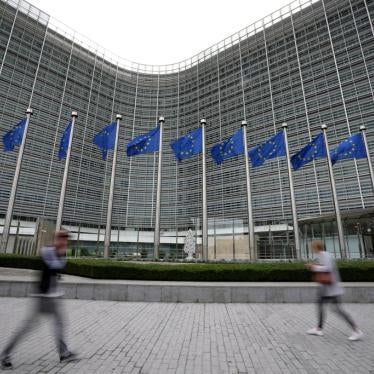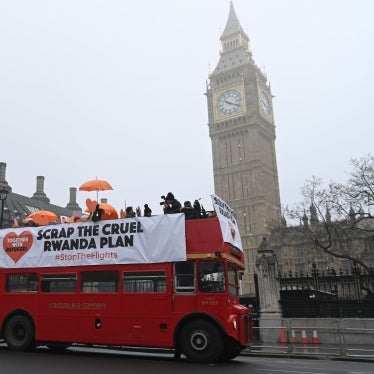(New York) – The Chinese government’s repression of political dissent in Tibetan areas warrants fact-finding visits by United Nations human rights experts, Human Rights Watch said today, releasing a new compilation of cases and sentences against Tibetans.
On February 21, 2018, six UN experts called for the release of Tibetan language rights advocate Tashi Wangchuk, who awaits sentencing on baseless charges of “inciting separatism.” The Tibetan Centre for Human Rights and Democracy reported that, in January, veteran dissident Tsegon Gyal was sentenced to three years in prison, also for “inciting separatism,” charges that the UN Working Group on Arbitrary Detention last year said had “no legal basis.” These cases fit a larger pattern of arbitrary and incommunicado detention, followed by closed trials resulting in long sentences, Human Rights Watch said.
“The harsh sentences handed down to peaceful Tibetan dissidents fly in the face of Chinese government claims to merely be enforcing the law,” said Sophie Richardson, China director at Human Rights Watch. “China should invite UN rights experts to assess the imprisonment of Tibetans denied access to family and counsel, mistreated in custody and unjustly convicted.”
It is difficult to assess how many Tibetans are, or have been, imprisoned in recent years for dissenting views or to learn the details of their cases: information about sentences from Tibetan areas is tightly restricted, and people who report detentions and prosecutions abroad are themselves at risk of arrest.
One of the few remaining sources are reports that appear in Tibetan exile media when prisoners are released. While such reports appear years after the arrests that led to imprisonment, they set forth basic facts about the cases, and thus provide a basis for identifying trends. The analysis that follows is based on Human Rights Watch review of such reports since 2016. These 30 cases are consistent with the patterns of a 2016 Human Rights Watch report on patterns of detentions and prosecutions in Tibet.
One cluster of cases reflects the Chinese government’s response to the wave of self-immolation protests in 2011-12, in which dozens of Tibetans attempted public suicides to draw attention to the denial of basic freedoms. In these 10 cases, courts handed down sentences ranging from three to seven years in prison for alleged involvement in self-immolation protests. Their offenses, where known, include attempting to prevent security forces from seizing the remains of protesters, and consoling bereaved relatives. Some were relatives and associates, accused of inciting the protests. Three of the 10 were reportedly released in poor health due to alleged mistreatment in custody. Another three were monks from Kirti monastery in Sichuan province, who were detained as they attempted self-immolations and subsequently given five-year prison sentences, despite Premier Wen Jiabao’s 2012 reassurance that the central government regarded them as “innocent.”
Another cluster of cases consist of four monks and two laymen, detained for their involvement in the widespread peaceful protests in March and April 2008. Among them, monk Labrang Jigme served three successive incarcerations since 2008 and frequent hospitalization following alleged torture in custody. Choktrin Gyatso was the only one of three monks at Tsang monastery in Gepasumdo county to complete their nine-year prison sentences; two colleagues were released early in poor health due to alleged mistreatment in custody. Layman Jampal was released early from a 13-year sentence due to poor health.
Six of those released are popular singers, who had been sentenced to four to six years in prison for performing songs considered to promote Tibetan nationalism, though the exact charges against them are not known.
Jamyang Kunkhyen and senior monk Atruk Lopo – relatives of Ronggye Adrak, who spoke out against the Chinese government at a public event in Litang in 2007, – were sentenced to 10 years in prison for sharing information about the case. Veteran dissident Sonam Gyalpo was rearrested in 2005 for possession of photos of the Dalai Lama and related literature, and sentenced to 12 years.
Tsegon Gyal, a former police forensic analyst and crime journalist, was originally sentenced to 16 years in prison in 1993 for allegedly forming an underground political organization, although the Qinghai province Higher People’s Court later reduced his sentence to six years. The grounds for his detention in December 2016 and conviction for “separatism” are not clear, but are apparently related to a social media post in which he criticized the government’s “nationality unity” policies.
UN scrutiny of China’s human rights record, including China’s 2008 and 2013 Universal Periodic Reviews, as well as its 2015 review under the Convention against Torture, were critical of restrictions on Tibetans’ civil, cultural, economic, and political rights. In February 2017, six UN special rapporteurs formally expressed concern to the Chinese government about the mass expulsion in late 2016 of monks and nuns, and the demolition of living quarters at the Larung Gar monastery in Kandze, Sichuan province.
Chinese authorities should cease prosecuting people for peaceful dissent, including under abusive charges such as “endangering state security” and “separatism,” Human Rights Watch said. The government should grant access to Tibetan areas for UN rights experts to document alleged rights violations and report publicly on possible accountability measures.
“The situation in Tibet will continue to deteriorate, so long as Chinese authorities prevent Tibetans from exercising their basic rights,” Richardson said. “China could show the world they are serious about addressing these rampant abuses by admitting UN rights experts into Tibetan areas.”
Reported releases of Tibetan political prisoners, June 2016-February 2018
1. Monk Jamyang Puntsok, from the Kirti monastery, sentenced to seven-and-a-half years in prison for alleged involvement in the first self-immolation protest in 2009, was released in September 2016.
2. Ludrup, one of five monks from the Tsodun Kirti monastery charged with involvement in the 2012 self-immolation protest there, was released on September 2, 2016 after five years of a six-year prison term, apparently for good behavior.
3. Jamyang Kunkhyen, detained in 2007 for sending abroad photos of Ronggye Adrak’s public protest in Litang, was released in August 2016 after nine years of a 10-year term for “espionage and inciting separatism.” He is reportedly in poor health.
4. Choedzin, from Dzamtang, Sichuan province, was released in September 2016 after completing a three-year prison sentence for alleged involvement in a self-immolation protest.
5. Pema Trinley and Chakdor, popular singers from Ngaba county, Sichuan, detained in July 2012 for singing “reactionary” songs, were released in September 2016.
6. Sengdra, a local official from Gabde, Qinghai, detained in December 2014 for questioning allocation of government funds, was released in October 2016 after completing a 15-month sentence.
7. Labrang Jigme (known as Jigme Go-ril) was released in October 2016 under strict control after completing a five-year prison sentence. This was his third imprisonment since 2008. He went to the hospital in December 2016 for further treatment of injuries sustained in custody.
8. Kirti monk Losang Sanggye was released in November 2016 in poor health. He was detained in August 2012 for alleged involvement in a self-immolation protest at the monastery.
9. Sherpel, a layman from Serta, Sichuan, detained in January 2012 for alleged involvement in a self-immolation protest, was released in November 2016.
10. Villagers Drolma Tso and Kunme, both detained in December 2013 for alleged involvement in a self-immolation protest and sentenced to three years in prison on “intentional homicide” charges, were released in early December 2016. Drolma Tso was in very poor health.
11. Aku Gyatak, a village leader from Rebkong, Qinghai, detained in November 2012 for consoling a self-immolator’s family, was released early from an unknown sentence in December 2016.
12. Sonam Yarpel, a monk from Sershul, Sichuan, detained in November 2014 for a solo protest, was released from the county jail on December 21, 2016.
13. The singer Amchok Pulchung from Martang, Sichuan, detained in 2012 for writing songs in praise of the Dalai Lama and criticizing Chinese rule in Tibet, was released on February 2, 2017 after completing a four-year prison sentence.
14. Yonten, a monk at Tangkor Soktsang monastery in Dzorge, Sichuan, detained in August 2013 for alleged involvement in a self-immolation protest, was released in January 2017 after completing a three-and-a-half-year prison sentence.
15. Trinley Tsering, a Kirti monk detained for his role in the 2008 protests in Ngaba county, was released on March 31, 2017, after nine years in prison.
16. Kirti monk Losang Konchok, who attempted self-immolation in September 2011, was released in March 2017.
17. Kirti monk Losang Kelsang, who attempted self-immolation in September 2011, was released in July 2017.
18. Kirti monk Losang Gyatso, who attempted self-immolation in February 2012, was released in May 2017.
19. Tsultrim Gyatso, a monk at Amchok Tsenyi monastery in Ngaba county, Sichuan, detained in 2008 for leading a protest in Tsenyi township, was released in April 2017 on completion of his sentence.
20. Choktrin Gyatso, a monk at Tsang monastery in Gepasumdo, Qinghai, one of three monks given long prison sentences for their role in the 2008 protests, was released in April 2017 after completing a nine-year sentence. His two colleagues were released earlier due to poor health.
21. Tsedrup Kyi, a woman from Pema, Qinghai, sentenced to four years in prison for protecting the remains of a self-immolation protester in December 2012, was released in April 2017, in poor health.
22. Jampal, a man from Machu, Gansu province, detained in March 2008 for his role in the protests and sentenced to 13 years in prison, was released early due to failing health in April 2017.
23. Kelsang Yarpel, a famous singer and musician detained in July 2013 for the political messages of his songs and sentenced to four years in prison in November 2014, was released in July 2017.
24. Rebkong monk Gomar Choepel, detained in July 2015 for possession of Dalai Lama photos and related literature and sentenced to two years in prison for “state subversion,” was released in July 2017 at the end of his term.
25. Senior Litang monk Atruk Lopo, sentenced to 10 years in prison for involvement in the protest of his nephew Ronggye Adrak, was released in August 2017.
26. Veteran dissident Sonam Gyalpo, one of the 21 Drepung monks who led independence protests in Lhasa in 1987 and who had been rearrested and sentenced to 12 years in prison in 2005 for possession of photos of the Dalai Lama and related literature, was released in August 2017. Since 1987 he has spent a total of 16 years in prison.
27. Lobsang Jinpa, a monk from Nyatso Zilkar monastery, arrested in a September 2012 raid on the monastery by security forces and sentenced to five years in prison on February 23, 2013 for writing a song in praise of the Panchen Lama, was released on October 30, 2017. He is known to have received medical treatment during his prison term. The well-known singer Lolo was sentenced to six years in prison at the same time.
28. Geshe Tsewang Namgyal, a senior monk at Drango monastery, detained for his alleged role in the 2012 popular protest in Drango county town and sentenced to six years in prison, was released in January 2018. Upon release, he was unable to walk properly, apparently due to mistreatment in custody.
29. Gartse Jigme, a monk scholar and well-known author, detained for the second time in 2013 and sentenced to five years in prison for his writings on contemporary affairs, was released in February 2018, a month after completing his sentence.
30. Shawo Tashi, a popular singer detained in 2012 for allegedly sympathizing with the self-immolation protests in his native Rebkong and sentenced to five years in prison, was released in November 2017 according to The Tibetan Centre for Human Rights and Democracy (different release dates have been reported in other media).
